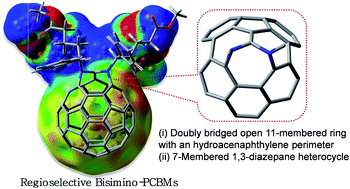Regioselective 1,2,3-bisazfulleroid: doubly N-bridged bisimino-PCBMs for polymer solar cells†
Abstract
The direct bisaddition of

* Corresponding authors
a
Interdisciplinary School of Green Energy and KIER-UNIST Advanced Center for Energy, Low Dimensional Carbon Materials Center, Ulsan National Institute of Science and Technology (UNIST), Ulsan 689-798, Korea
E-mail:
yang@unist.ac.kr
Fax: +82-52-217-2909
Tel: +82-52-217-2920
b
Department of Physics, Pukyong National University, Busan 608-737, Korea
E-mail:
spark@pknu.ac.kr
c
Center for Energy Efficient Materials, University of California Santa Barbara, CA 93106, USA
E-mail:
wudl@chem.ucsb.edu
d Department of Materials Physics, Dong-A University, Busan 604-714, Korea
The direct bisaddition of

 Please wait while we load your content...
Something went wrong. Try again?
Please wait while we load your content...
Something went wrong. Try again?
B. Kim, J. Lee, J. H. Seo, F. Wudl, S. H. Park and C. Yang, J. Mater. Chem., 2012, 22, 22958 DOI: 10.1039/C2JM35070J
To request permission to reproduce material from this article, please go to the Copyright Clearance Center request page.
If you are an author contributing to an RSC publication, you do not need to request permission provided correct acknowledgement is given.
If you are the author of this article, you do not need to request permission to reproduce figures and diagrams provided correct acknowledgement is given. If you want to reproduce the whole article in a third-party publication (excluding your thesis/dissertation for which permission is not required) please go to the Copyright Clearance Center request page.
Read more about how to correctly acknowledge RSC content.
 Fetching data from CrossRef.
Fetching data from CrossRef.
This may take some time to load.
Loading related content
